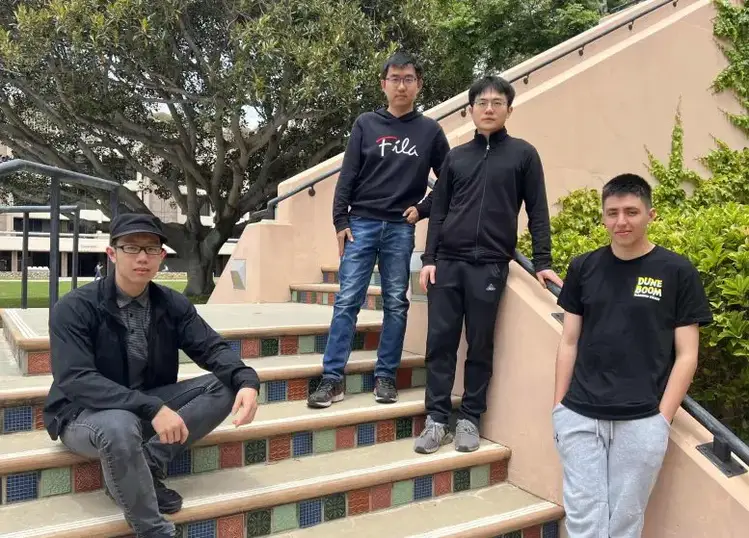Scientists have discovered a new state of matter, termed a “bosonic correlated insulator,” through the interaction of bosonic particles called excitons. This research could pave the way for new understandings in condensed matter physics and the creation of new bosonic materials.

Researchers have discovered a new state of matter, which they call a “bosonic correlated insulator,” a crystalline assembly of bosonic particles, specifically excitons.
Take a lattice — a flat section of a grid of uniform cells, like a window screen or a honeycomb — and lay another, similar lattice above it. But instead of trying to line up the edges or the cells of both lattices, give the top grid a twist so that you can see portions of the lower one through it. This new, third pattern is a moiré, and it’s between this type of overlapping arrangement of lattices of tungsten diselenide and tungsten disulfide where UC Santa Barbara physicists found some interesting material behaviors.
“We discovered a new state of matter — a bosonic correlated insulator,” said Richen Xiong, a graduate student researcher in the group of UCSB condensed matter physicist Chenhao Jin, and the lead author of a paper in the journal Science. According to Xiong, Jin and collaborators from UCSB, Arizona State University and the National Institute for Materials Science in Japan, this is the first time such a material has been created in a “real” (as opposed to synthetic) matter system. The unique material is a highly ordered crystal of bosonic particles called excitons.
“Conventionally, people have spent most of their efforts to understand what happens when you put many fermions together,” Jin said. “The main thrust of our work is that we basically made a new material out of interacting bosons.”

Two stacked with one slightly offset create a new pattern called a moiré. Credit: Matt Perko
Bosonic. Correlated. Insulator.
Subatomic particles come in one of two broad types: fermions and bosons. One of the biggest distinctions is in their behavior, Jin said.
“Bosons can occupy the same energy level; fermions don’t like to stay together,” he said.“Together, these behaviors construct the universe as we know it.”
Fermions, such as electrons, underlie the matter with which we are most familiar as they are stable and interact through the electrostatic force. Meanwhile, bosons, such as photons (particles of light), tend to be more difficult to create or manipulate as they are either fleeting or do not interact with each other.
A clue to their distinct behaviors is in their different quantum mechanical characteristics, Xiong explained. Fermions have half-integer “spins” such as 1/2 or 3/2, while bosons have whole integer spins (1, 2, etc.). An exciton is a state in which a negatively charged electron (a fermion) is bound to its positively charged opposite “hole” (another fermion), with the two half-integer spins together becoming a whole integer, creating a bosonic particle.

The Jin Lab, from left to right: Tian Xie, Richen Xiong, Chenhao Jin, Samuel L. Brantly. CreditSonia Fernandez
To create and identify excitons in their system, the researchers layered the two lattices and shone strong lights on them in a method they call “pump-probe spectroscopy.” The combination of particles from each of the lattices (electrons from the tungsten disulfide and the holes from the tungsten diselenide) and the light created a favorable environment for the formation of and interactions between the excitons while allowing the researchers to probe these particles’ behaviors.
“And when these excitons reached a certain density, they could not move anymore,” Jin said. Thanks to strong interactions, the collective behaviors of these particles at a certain density forced them into a crystalline state, and created an insulating effect due to their immobility.
“What happened here is that we discovered the correlation that drove the bosons into a highly ordered state,” Xiong added. Generally, a loose collection of bosons under ultracold temperatures will form a condensate, but in this system, with both light and increased density and interaction at relatively higher temperatures, they organized themselves into a symmetric solid and charge-neutral insulator.
The creation of this exotic state of matter proves that the researchers’ moiré platform and pump-probe spectroscopy could become an important means for creating and investigating bosonic materials.
“There are many-body phases with fermions that result in things like superconductivity,” Xiong said. “There are also many-body counterparts with bosons that are also exotic phases. So what we’ve done is create a platform, because we did not really have a great way to study bosons in real materials.” While excitons are well-studied, he added, there hadn’t until this project been a way to coax them to interact strongly with one another.
With their method, according to Jin, it could be possible not only to study well-known bosonic particles like excitons, but also to open more windows into the world of condensed matter with new bosonic materials.
“We know that some materials have very bizarre properties,” he said. “And one goal of condensed matter physics is to understand why they have these rich properties and find ways to make these behaviors come out more reliably.”
Reference: “Correlated insulator of excitons in WSe2/WS2 moiré superlattices” by Richen Xiong, Jacob H. Nie, Samuel L. Brantly, Patrick Hays, Renee Sailus, Kenji Watanabe, Takashi Taniguchi, Sefaattin Tongay and Chenhao Jin, 11 May 2023, Science.DOI: 10.1126/science.add5574





